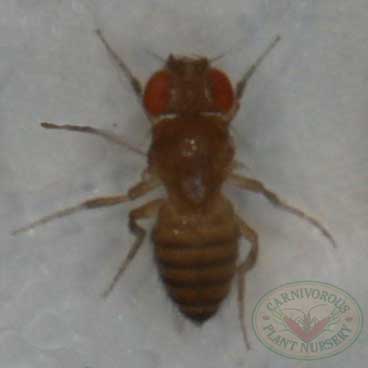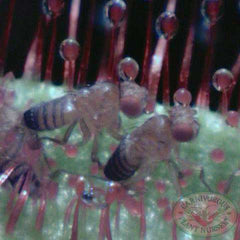
Fruitfly Culture



Wingless and Flightless Fruit Flies are a perfect live food for small-trap carnivorous plants.
- Natural source of nitrogen.
- Just sprinkle into traps.
- Easy to use and keep.
- Clean and odorless.
- Lasts for years.
Feeding Carnivorous Plants.
Carnivorous plants grow in the nutrient-poor soils of bogs. The constant flow of water through a bog leaches away soil minerals including nitrogen, which is necessary for healthy plant growth. Carnivorous plants have adapted unique methods to lure, trap and digest insect victims to obtain nitrogen. When grown indoors there can be too few insects available for strong growth and it becomes useful to feed the plants. Wingless and/or Flightless Fruit Flies are an ideal food, especially for small-trap carnivorous plants including sundews, butterworts, venus flytraps, cephalotus and pitcher plants. The fruit flies are easily sprinkled into the traps for quick, natural feeding. Wingless fruit flies cannot fly and are very simple to culture. They are clean and odorless. They need very little space, and can be grown year-round. Nothing beats live food for great carnivorous plant growth.
Culturing Fruit Flies.
Wingless and Flightless Fruit Flies are very simple to culture. The only materials necessary are small vials, plugs and medium. Upon receiving the culture, remove the cap, but leave the foam plug in place. Keep them at room temperature, between 68-75°F (20-25°C) and out of direct sunlight. Lower temperatures will slow their growth, and higher temperatures will shorten their life cycle, but may promote the growth of mold, bacteria and mites. The flies will do fine in the plugged vial for a month or more. Adults can be sprinkled onto carnivorous plant traps as needed. To start a new culture, add a few flies into a clean vial with fresh medium.
Fruit Fly Life Cycle.
Wingless fruit flies are a natural genetic variation of the common fruit fly, Drosophila melanogaster. They will remain wingless as long as they are kept in plugged containers and only allowed to breed with other wingless fruit flies. They reach breeding size in only two weeks at 70° F (21°C). A single female can lay more than 500 eggs in a week. There are four distinct stages in the fruit fly life cycle: egg, larva, pupa and adult. Within one day the larva hatch from the egg and begin feeding and burrowing thorough the medium. Larva feed in the medium for a week, molting twice in that time. They crawl above the medium to form dark colored pupa on a dry surface. The pupae metamorphose and emerge as adults in six days. Two days after emerging a female can mate and start to lay eggs. Adults may live for several weeks or longer.
Flightless Fruit Flies are very similar in life cycle to Wingless Fruitflies. Their life cycle is a few days long and the females do not lay quite as many eggs.
Creating New Cultures.
About once a month prepare a fresh culture. Add one ounce of flaked medium to a clean dry vial. Pour in an equal amount of cool tap water. Sprinkle a few grains of dry viable yeast onto the surface. Too much yeast will produce excess CO2 causing sterility or even death for the fruit flies. Six grains of yeast are adequate. Let the medium stand for a minute or more before adding the new flies. Simply sprinkle a few flies from an old culture into the freshly prepared vial. It only takes one fertile female, but adding about a dozen flies works well. Plug the vial with a clean foam plug.
